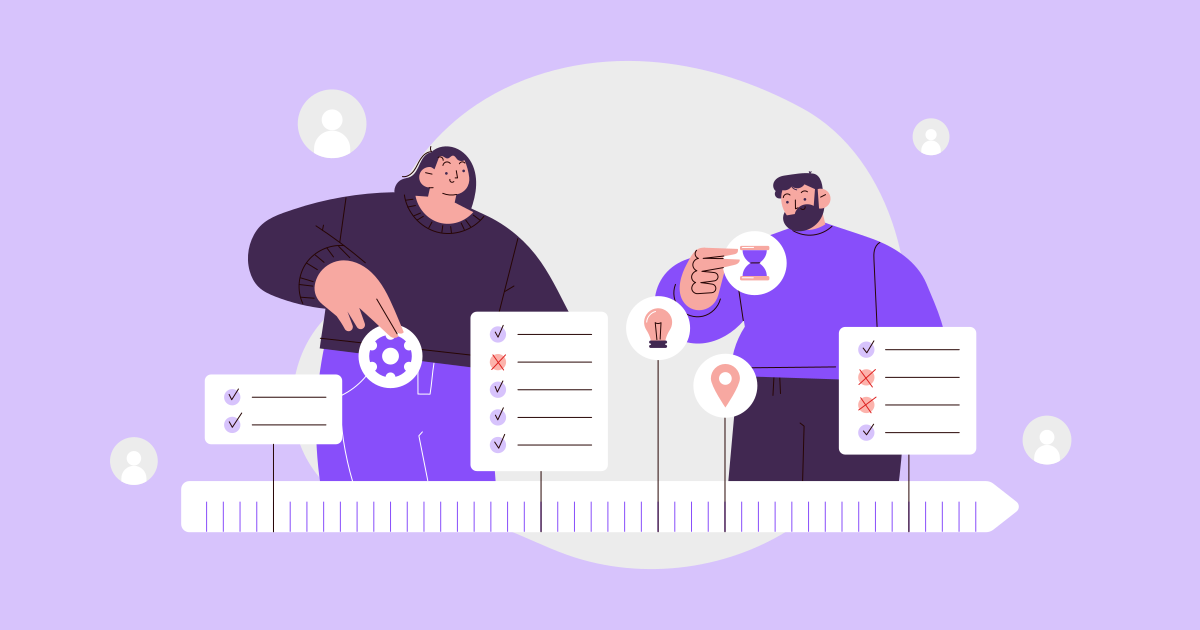Table of content
Outbound prospecting often gets a bad reputation. Cold calls get ignored. Emails go unanswered. LinkedIn messages? Left on “Seen.”
If your sales prospecting techniques feel outdated or forced, you’re not alone. The truth is, buyers have changed. But many B2B sales teams are still using playbooks from a different era.
Here’s the good part. Outbound isn’t broken. It just needs a smarter approach.
With accurate data, AI-powered personalization, and multi-channel outreach, modern prospecting methods can still drive real conversations and qualified leads.
In this guide, we’re diving deep into outbound prospecting. What it is, why it still matters, and how it’s evolved.
You’ll learn the best strategies, which channels work, how to build winning outreach sequences, and what actually gets replies in 2025.
Time to make outbound cool again.
What Is Outbound Prospecting?
Outbound prospecting means reaching out to people who haven’t shown interest in your product yet. It’s a way to start sales conversations instead of waiting for leads to come in.
This method is active. Sales reps find potential buyers and contact them directly. These prospects may not know about your company, but they fit your ideal customer profile.
Outbound is different from inbound. In inbound, leads come to you through blogs, ads, or social media. In outbound, you take the first step.
Common outbound prospecting methods include:
- Cold calls
- Cold emails
- LinkedIn messages
- Video or voice messages
Outbound gives sales teams control. It helps you target the right people at the right time. It’s fast, direct, and measurable.
In B2B sales, outbound prospecting is key. It helps build pipeline, reach decision-makers, and close deals faster. When done right, it turns strangers into paying customers.
Why Outbound Prospecting Still Drives Growth in 2025
Outbound prospecting remains a core strategy in modern B2B sales. While inbound tactics have grown in popularity, outbound still plays a vital role in hitting pipeline goals, especially when results need speed, precision, and control.
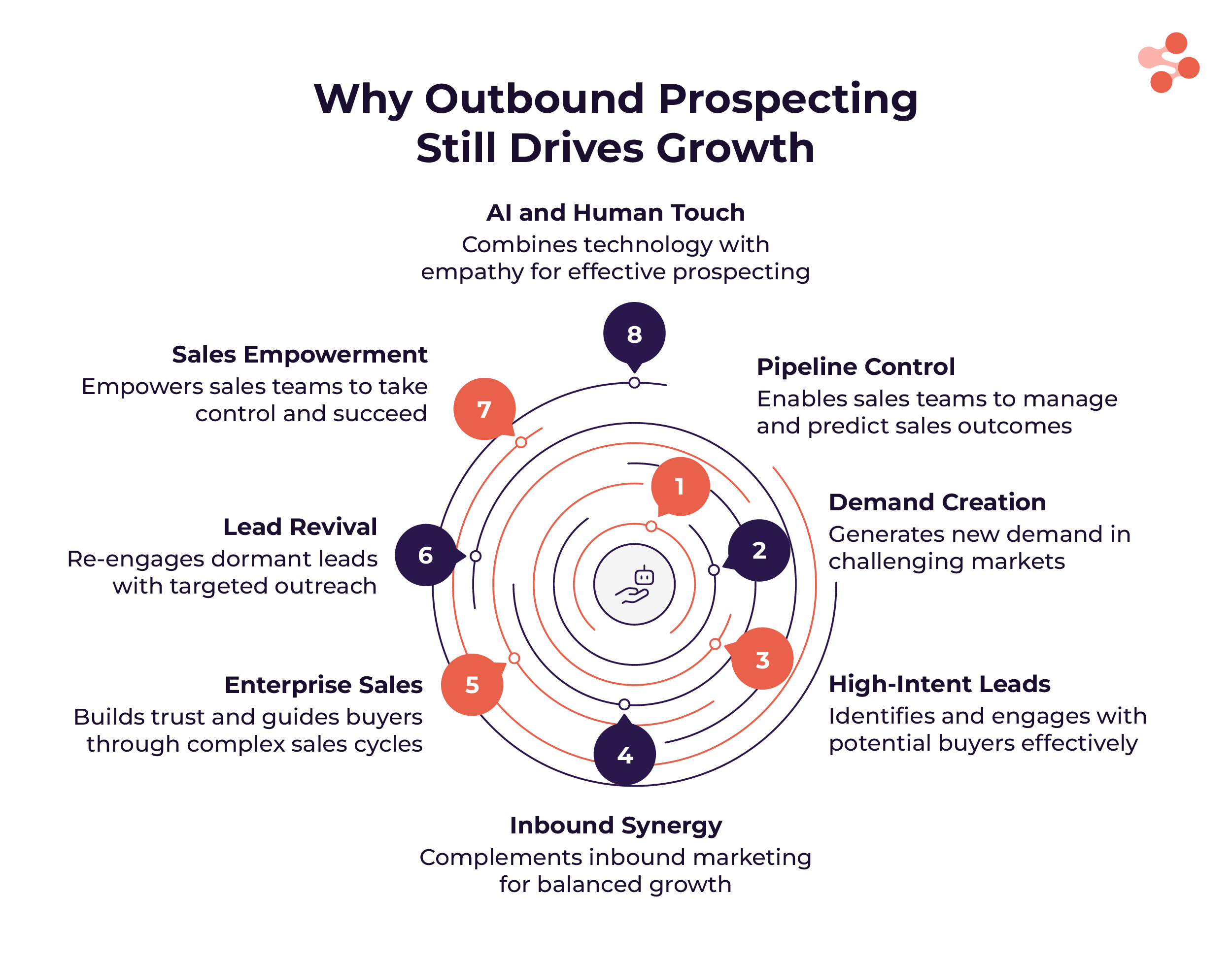
1. Full Pipeline Control and Predictable Outcomes
Inbound marketing depends on attracting interest. Outbound flips the model. It gives sales teams control. You choose who to target, when to engage, and how to tailor the outreach. This control helps build a pipeline faster and with more consistent results.
When inbound dries up or slows down, outbound fills the gaps. Teams don’t wait. They act.
2. Faster Demand Creation in Slow Markets
Outbound prospecting is often the fastest way to generate new demand—especially in tight markets. During economic slowdowns or budget freezes, buyers may not be actively searching. That’s where outbound wins.
By identifying the right accounts and reaching out with a clear value proposition, you create demand where there was none. It’s about activating interest, not waiting for it.
3. High-Intent Leads Through Smart Targeting
Outbound today isn’t about mass emails or cold calls. Modern tools use real-time intent data, firmographics, technographics, and buying signals.
With this intel, reps can:
- Pinpoint who’s ready to buy
- Tailor messages to specific pain points
- Trigger outreach at the right time
The result? Better open rates. Stronger replies. More booked meetings.
4. Works Hand-in-Hand With Inbound Marketing
Outbound does not compete with inbound. It completes it.
Inbound builds long-term brand trust. Outbound drives short-term pipeline. Together, they create a balanced growth engine.
For example:
- Use inbound to nurture passive interest.
- Use outbound to chase high-fit accounts not yet engaging.
This mix gives companies the agility to pivot when market behavior shifts.
5. Essential for Enterprise and Large Deal Sales
Bigger deals take time. They need trust. Outbound prospecting builds that trust through repeated, thoughtful outreach.
Enterprise sales cycles often span months or even years. Outbound lets reps stay top of mind, build rapport, and guide buyers through complex journeys.
Account-based selling thrives on this type of proactive outreach.
6. Revives Lost or Dormant Leads
What happens when leads go cold? Outbound brings them back.
With targeted emails, direct calls, or retargeting campaigns, reps can re-engage leads who once showed interest. Often, these contacts just need a nudge or a better-timed offer.
It’s not about starting from scratch. It’s about reactivating what you’ve already earned.
7. Empowers Sales Teams to Win
Outbound puts the power in the rep’s hands. It builds confidence, resilience, and skill.
Instead of waiting on inbound leads, outbound-focused sellers learn how to:
- Build their own pipeline
- Hit quotas even in slow quarters
- Take ownership of their success
This proactive mindset separates top performers from the rest.
8. Powered by AI, Data, and Human Touch
Outbound has evolved. Today, it's smarter, faster, and more human.
AI tools help analyze behavior, identify patterns, and suggest next-best actions. Sales engagement platforms automate workflows. Personalization tools help tailor every message.
But the human element still matters. The best outbound is a mix of tech and empathy—precision with relevance.
How to Build an Outbound Prospecting Strategy That Works
A strong outbound prospecting strategy helps you find the right leads, connect with them, and convert them. It takes planning, smart tools, and consistent effort. Follow these steps to build a simple, clear, and effective process.
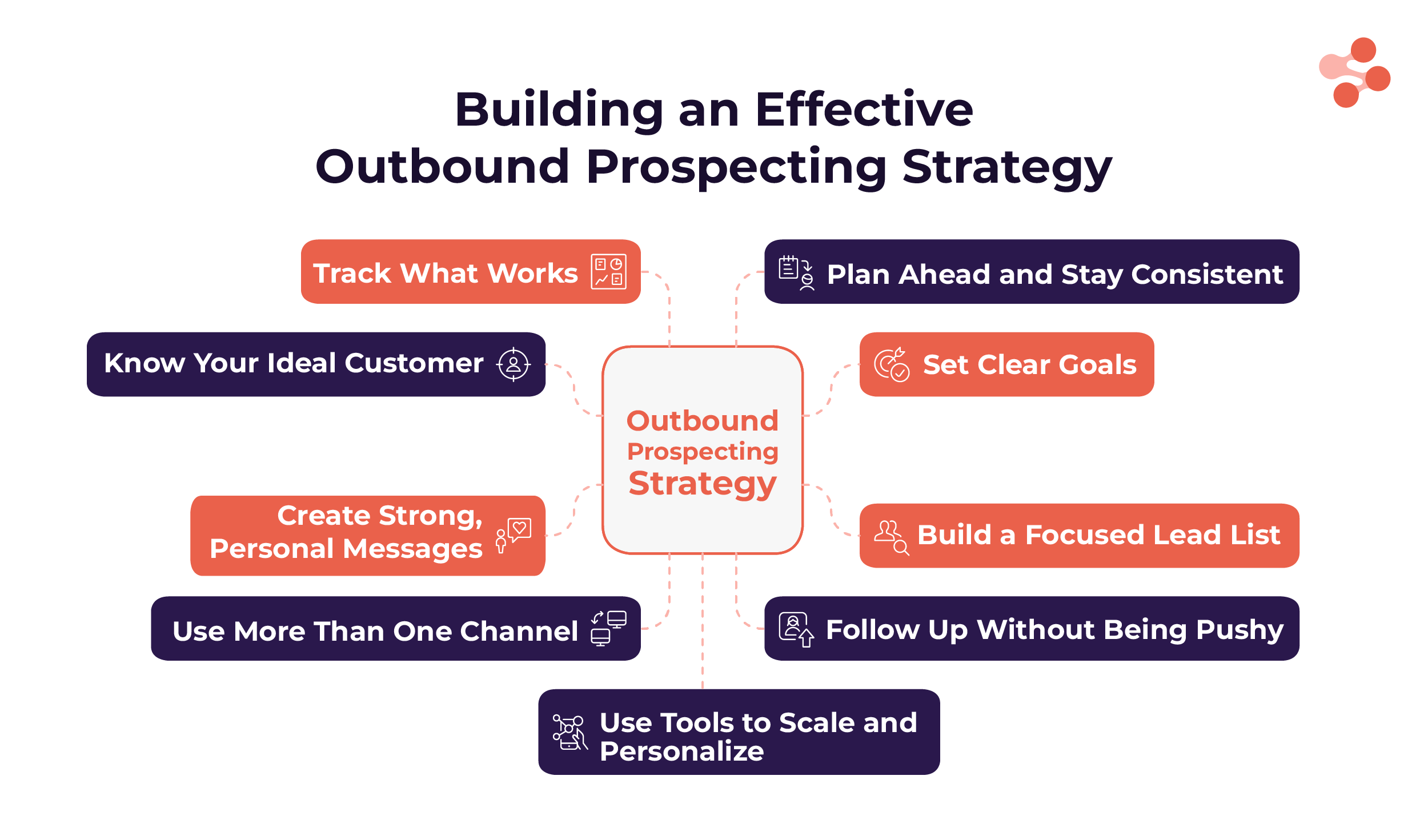
1. Know Your Ideal Customer
Start with your Ideal Customer Profile (ICP). This is a clear picture of the people and companies you want to target. Look at their industry, company size, job roles, pain points, and buying behavior.
When you know who you’re selling to, you avoid wasting time. Your message hits harder, and your results improve.
2. Set Clear Goals
Decide what success looks like. This could be:
- Number of leads per week
- Meetings booked
- Emails replied to
- Deals added to pipeline
Goals give your team direction. They keep everyone focused and help you measure what’s working.
3. Build a Focused Lead List
Don’t target everyone. Build a lead list of prospects who match your ICP. Use a B2B data provider to filter by job title, industry, revenue, or tech stack.
It’s better to reach 50 right-fit leads than blast 500 random ones. In outbound prospecting, precision always beats volume.
4. Create Strong, Personal Messages
Write messages that feel personal, not scripted. Focus on their problems, not your product. Use short subject lines. Get to the point fast.
A good message does three things:
- Shows you did your research
- Offers value
- Ends with a clear call to action
Your first message should open the door. Don’t try to close the sale right away.
5. Use More Than One Channel
Don’t rely on just email or phone. Use a mix:
- Cold calls
- Emails
- LinkedIn messages
- Social touches
The more places your prospect sees you, the more likely they’ll respond. A multi-touch approach improves reply rates.
6. Follow Up Without Being Pushy
Most prospects won’t reply to the first message. That’s normal. Stay persistent. Follow up at least 2 to 3 times.
Change your channel or message slightly each time. Stay friendly and respectful. Never copy-paste the same message.
7. Track What Works
Use tools to track:
- Open and reply rates
- Meetings booked
- Lead-to-close ratio
Test different subject lines, messages, and sending times. Use what works. Drop what doesn’t. Let the data guide you.
8. Plan Ahead and Stay Consistent
Set daily and weekly activity targets. Block time for prospecting. Review progress each week and adjust if needed.
A repeatable system helps your team stay on track, even when things get busy.
9. Use Tools to Scale and Personalize
Modern tools make outbound smarter. Use AI to:
- Spot intent signals
- Find accurate contact data
- Personalize messages at scale
These tools save time and improve results. Just remember to keep the human touch.
Top Outbound Prospecting Channels to Use in 2025
Outbound prospecting in 2025 is no longer about picking one channel and sticking to it. The most successful sales teams use a multi-channel approach. This means combining several touchpoints to connect with prospects where they are most active. Here are the top channels that work best today.
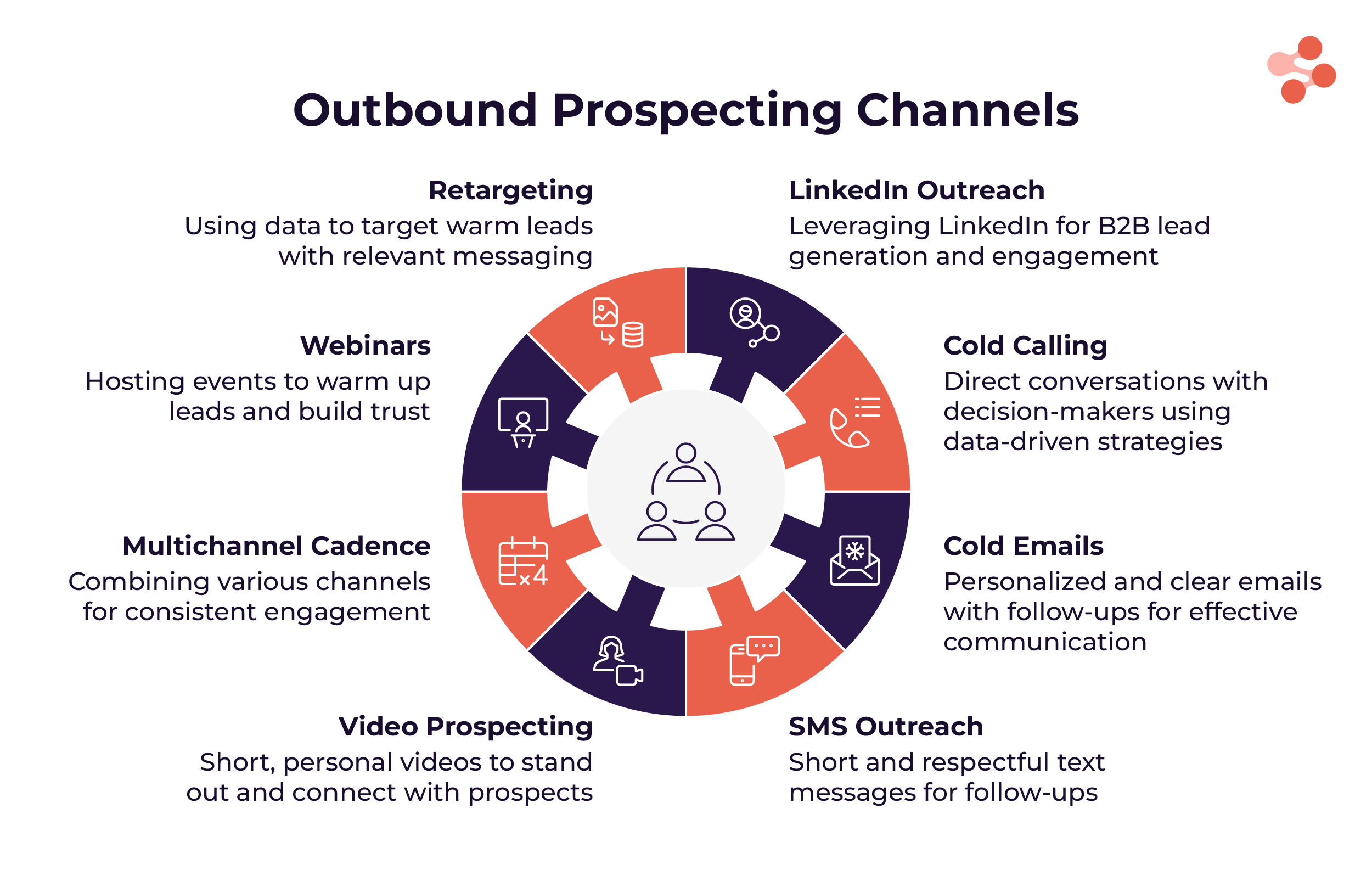
1. LinkedIn Outreach and Social Selling
LinkedIn prospecting is one of the best ways to reach B2B leads in 2025. You can filter people by job title, industry, location, or company size. A LinkedIn email finder tool like SMARTe helps you find verified contact details and reach decision-makers faster.
To boost LinkedIn lead generation, send personal connection requests. Like and comment on posts. Start direct chats. Share helpful content to build trust over time.
More than 80% of B2B marketers use LinkedIn today. It’s a key part of any smart outbound sales strategy.
2. Cold Calling
Is cold calling dead? No—not if it’s done right.
Cold calling still delivers real conversations. It’s one of the few ways to speak directly with decision-makers. But to make it work, you need more than a phone and a script—you need data.
Start with a reliable phone number database. A tool like SMARTe gives you access to direct dials and 70% mobile number coverage. This helps you get past gatekeepers and reach the right person faster.
Build a targeted cold call list. Know who you’re calling, what they care about, and how you can help. Keep it short, clear, and focused on value. Real conversations start with real insights.
3. Cold Emails
Cold email is still one of the most powerful outbound channels in B2B sales. It works best when it’s part of a multi-touch strategy and backed by a quality email list.
To drive real results, your cold emails must be personal, short, and clear. Use subject lines that stand out. End with a simple, direct call to action. And always follow up—most replies come after the second or third message.
For effective email lead generation, start with accurate contact data. SMARTe helps you build verified CEO email lists and CMO email lists, so you’re not guessing who to reach. It powers B2B email marketing with clean, up-to-date data that gets your message in front of the right people.
Great cold emails start with great data. The rest is about timing, clarity, and consistent follow-ups.
4. SMS and Text Outreach
SMS messages have open rates near 98 percent. That makes text outreach a powerful tool if used right.
Keep messages short and respectful. Use it as a follow-up to emails or calls—not as a first touch. It works well when prospects have already shown some interest.
5. Video Prospecting
A short video adds a personal touch that text alone can’t match. It shows effort and helps you stand out in a crowded inbox.
You don’t need expensive tools. A quick intro video explaining who you are and how you can help is enough. Keep it under 60 seconds. Be human, clear, and direct.
6. Multichannel Cadence
Using several channels together gets better results. For example:
- Day 1: LinkedIn connection
- Day 2: Cold email
- Day 3: Follow-up call
- Day 5: SMS or video message
This keeps you top of mind without being annoying. Vary the timing and channel to boost engagement.
7. Webinars and Virtual Events
Hosting a webinar is a great way to warm up leads. Invite your target accounts. Share insights they care about. After the event, use outbound tactics to follow up.
This mix of inbound and outbound helps you build trust and create natural conversation starters.
8. Retargeting and CRM Tools
Smart prospecting uses data. Your CRM and ad tools can help you retarget website visitors or warm leads. Use insights like email opens, page visits, or past interactions to guide your outreach.
This makes your messaging timely and relevant, not random.
How to Create High-Converting Outreach Sequences
An outreach sequence is a set of messages you send over time to a prospect. The goal is to start a conversation without sounding aggressive or robotic.
The best sequences use more than one channel. This means you don’t just send an email and wait. You follow up using other platforms.
Here’s a simple example:
- Day 1: Send a cold email
- Day 3: Follow up with a LinkedIn message
- Day 5: Make a call and leave a voicemail
Spacing is key. Don’t send all your messages in one day. Give the person time to read, think, and reply.
Use a mix of formats. Some people check LinkedIn more than email. Others prefer calls. When you show up in different places, you’re more likely to get noticed.
Most prospects won’t respond to the first message. That’s normal. Stay consistent but polite. Don’t spam. Don’t pressure. Every message should add value or context.
Finally, test different sequences. Change your timing. Try new subject lines. See what gets more replies and adjust.
A high-converting outreach sequence is thoughtful. It respects your prospect’s time while keeping you in their line of sight.
Personalization and Messaging That Works
Personalization is what makes your outreach stand out. It's not just about using a first name. It's about showing you understand the person, their company, and their challenges.
Mention something specific. It could be:
- A recent company announcement
- A LinkedIn post they shared
- A tool they’re using
- A pain point common to their role
Make your message feel one-to-one, not one-to-many.
Bad Example:
“Hi Sarah, I thought you might be interested in our product.”
Too generic. It shows no effort.
Better Example:
“Hi Sarah, I saw [Company Name] is expanding into the APAC region. Our platform helps fast-growing teams like yours reduce onboarding time by 30 percent. Worth a quick chat?”
That’s specific, relevant, and offers value.
Another Good Example:
“Hi Mark, I noticed you recently hired 5 SDRs. Many teams at your stage use us to boost ramp time and improve cold outreach results. Open to a 10-minute call this week?”
Keep it short. Keep it clear. Focus on what matters to them, not what excites you.
End with a soft call to action:
- “Open to a quick chat?”
- “Does this sound worth exploring?”
- “Would next Tuesday work for a quick intro?”
Every message should answer: What’s in it for them? If it does, you’ll get more replies.
Outbound Prospecting Tools and Tech Stack
An efficient outbound prospecting strategy needs more than just effort—it needs the right tools. Your tech stack should simplify your workflow, improve targeting, and help you scale with accuracy.
Here are the essential tool categories every sales team should use:
CRM Platforms
A Customer Relationship Management (CRM) system keeps all your contact and deal data in one place. It tracks touchpoints, schedules follow-ups, and helps manage pipelines.
Top choices include:
- Salesforce
- HubSpot
CRM tools keep your outreach organized and help your team stay on track.
Email Automation Tools
Email sequencing tools help you send outreach messages at scale. They let you personalize emails, schedule follow-ups, and track opens and replies.
Popular tools:
- Outreach
- Mailshake
- Lemlist
Automation ensures that no lead falls through the cracks.
Prospecting and Data Intelligence Tools
Accurate contact data fuels your outbound engine. That’s where SMARTe stands out.
SMARTe is a modern sales intelligence platform built for GTM teams that need speed, accuracy, and global scale. It helps you find and reach the right decision-makers with verified, real-time data.
Why SMARTe?
- 281M+ B2B contacts and 65M+ company profiles
- 70% mobile number availability in North America, and strong global coverage
- Advanced filters to build precise prospect lists using criteria like job title, revenue, location, industry, or tech stack
- Real-time lead enrichment to fix incomplete or outdated records
- Seamless CRM integrations to push enriched data in one click
- Job change alerts to track champions and reduce churn
- Browser-based prospecting that reveals contact data right from LinkedIn or company websites
SMARTe doesn’t just give you data. It gives you control. You spend less time searching and more time connecting with buyers who match your ICP.
Whether you're cold calling or launching a multi-touch campaign, SMARTe helps you bypass gatekeepers, reach mobile numbers directly, and drive more conversations.
Why the Right Tech Stack Matters
The right tools help sales teams:
- Build better lists
- Reach more qualified prospects
- Personalize at scale
- Save hours on manual tasks
- Close more deals, faster
Outbound prospecting isn’t just about sending messages. It’s about reaching the right person, with the right data, at the right time. Tools like SMARTe make that possible.
Advanced Outbound Prospecting Strategies for 2025
Outbound prospecting has evolved. In 2025, it’s no longer about volume—it’s about precision, personalization, and timing. Modern sales teams use AI, automation, and intent data to connect with the right prospects at the right time, across the right channels.
Here are the most effective outbound prospecting strategies in 2025:
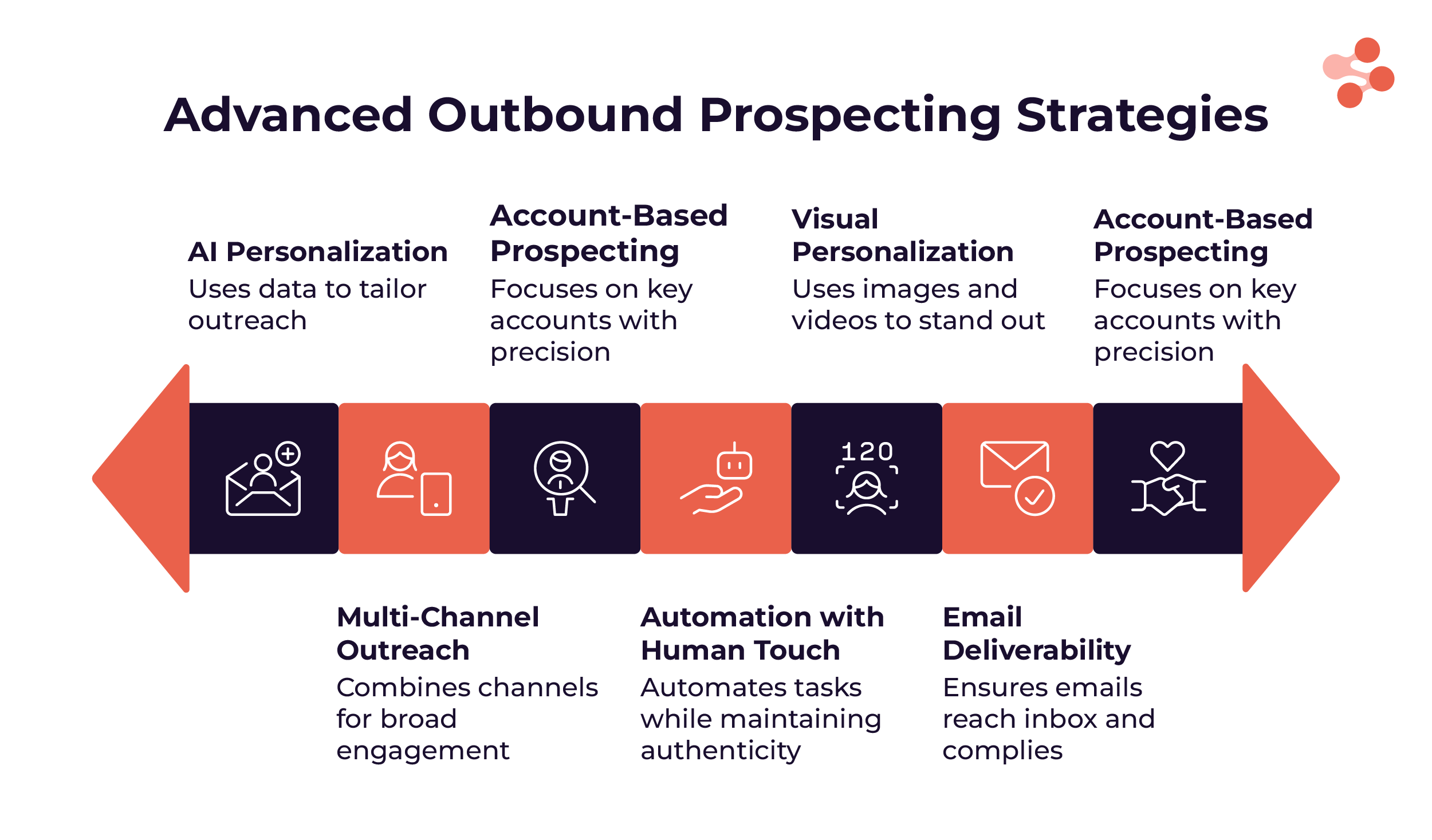
1. AI-Driven Personalization and Data Enrichment
Generic emails don’t convert. AI now powers real-time personalization by analyzing buyer behavior, job titles, firmographics, and company triggers.
Use tools that:
- Auto-fill data gaps in your CRM
- Suggest pain points based on job function
- Adapt messaging to each lead’s context
AI-driven enrichment platforms like SMARTe deliver verified contact details, mobile numbers, and job change alerts. This allows reps to reference recent news, tech stack changes, or industry shifts—boosting open and reply rates.
2. Multi-Touch, Multi-Channel Outreach
Buyers need more than one touch. In 2025, winning sequences blend multiple channels:
- Cold emails
- LinkedIn messages
- Phone calls and voicemails
- SMS or WhatsApp
- Personalized videos
- Retargeting ads
A proven outbound cadence includes 6 to 10 touches over 7 to 14 days. Each touch must feel fresh, not repetitive.
Prospecting also works better when you reach out to multiple stakeholders in a company. Tailor messages to each role to boost your chances of breaking in.
3. Account-Based Prospecting
Broad outreach is wasteful. High-performing teams use account-based sales prospecting to target key accounts with precision.
Steps to follow:
- Research accounts deeply—funding, hiring, product launches
- Identify the buying committee (influencers + decision-makers)
- Build messaging that matches their goals
AI helps here, too. It scores accounts based on firmographic and intent signals so you focus only on high-fit, high-intent prospects.
ABM combined with outbound improves conversion rates by as much as 30 percent.
4. Automation Without Losing the Human Touch
Outbound at scale needs automation—but not at the cost of authenticity.
Use tools like Clay, Make, or N8N to:
- Enrich leads
- Assign territories
- Trigger smart workflows
- Automate follow-ups
Integrate these with your CRM and enablement platforms. That way, reps spend less time on admin and more time engaging with prospects.
Just remember: Automation handles the delivery. You still own the message.
5. Visual and Video-Based Personalization
Go beyond text. In saturated inboxes, visual personalization stands out.
Add images or GIFs with:
- Prospect names
- Logos
- Industry stats
Short custom videos also work well. In 30 to 60 seconds, show you understand their problem and invite them to talk.
Tools like Vidyard and Loom make this fast and repeatable.
6. Email Deliverability and Compliance
In 2025, deliverability is a major challenge. Many emails never reach inboxes because of poor setup or spam triggers.
To stay out of spam:
- Set up SPF, DKIM, and DMARC properly
- Use warmed-up sending domains
- Avoid spammy words and overuse of links
- Personalize every message
Also, ensure GDPR and CAN-SPAM compliance—especially in global outreach.
7. Relationship-Focused Messaging
Prospecting is not just about booking a meeting. It’s about building trust.
Start every message with:
- Why you're reaching out
- Why it matters to them
- How you can solve a specific problem
Drop the hard-sell tone. Be helpful, not pushy. Add value before asking for time.
This approach leads to better conversations, stronger connections, and more closed deals.
Final Thoughts on Outbound Prospecting in 2025
And just like that, we’re at the end.
Outbound prospecting has come a long way—and when done right, it still delivers big results. The key is knowing what works today, not what worked five years ago.
Use clean data, personalize every message, mix your channels, and stay consistent. Test, tweak, and double down on what gets real replies.
Follow the strategies we’ve covered here, and you’ll start to see it click. More opens. More conversations. More wins.
Outbound isn’t dead. You just have to do it better.




